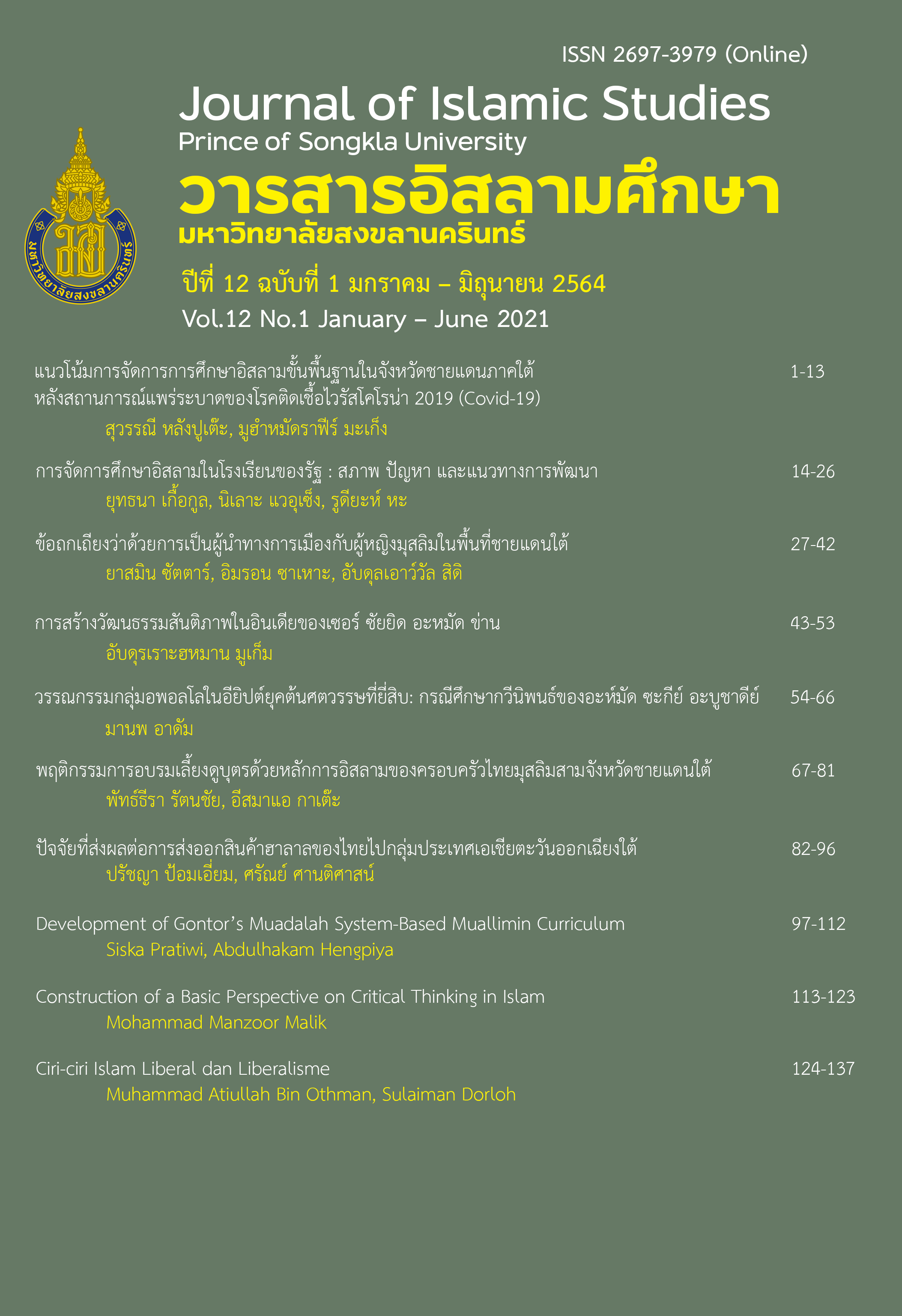พฤติกรรมการอบรมเลี้ยงดูบุตรด้วยหลักการอิสลามของครอบครัวไทยมุสลิมสามจังหวัดชายแดนใต้
คำสำคัญ:
พฤติกรรมการอบรมเลี้ยงดูบุตร, หลักการอิสลาม, ครอบครัวไทยมุสลิมบทคัดย่อ
จุดประสงค์ การศึกษาครั้งนี้มีวัตถุประสงค์เพื่อศึกษาระดับพฤติกรรมการอบรมเลี้ยงดูบุตรด้วยหลักการอิสลามของครอบครัวไทยมุสลิมสามจังหวัดชายแดนใต้
วิธีการศึกษา การศึกษาใช้ระเบียบวิธีวิจัยเชิงปริมาณ กลุ่มตัวอย่างที่ใช้ในการศึกษา ได้แก่ ครอบครัวไทยมุสลิมสามจังหวัดชายแดนใต้จำนวน 400 ครอบครัว (เก็บข้อมูลจากบิดาหรือมารดาต่อ 1 ครอบครัว) เครื่องมือที่ใช้ในการวิจัย ได้แก่ แบบสอบถามที่ผู้วิจัยสร้างขึ้น การวิจัยครั้งนี้ได้แบบสอบถามคืนมา 400 ฉบับ (100%) วิเคราะห์ข้อมูลใช้ค่าร้อยละ ค่าเฉลี่ย และค่าเบี่ยงเบนมาตรฐาน
ผลการศึกษา พบว่าครอบครัวไทยมุสลิมสามจังหวัดชายแดนภาคใต้มีระดับพฤติกรรมการอบรมเลี้ยงดูบุตรด้วยหลักการอิสลามในภาพรวมอยู่ในระดับมาก ( = 4.36, S.D = .769) และเมื่อพิจารณาเป็นรายด้าน พบว่าด้านที่มีค่าเฉลี่ยมากที่สุดคือ ด้านสังคม (
= 4.52, S.D = .645) รองลงมาคือ ด้านจริยธรรม (
= 4.52, S.D = .710) และน้อยที่สุดคือด้านสุขภาพ และด้านสติปัญญาและภาษา (
= 4.28, S.D = .842 และ .806ตามลำดับ)
การนำผลการวิจัยไปใช้ หน่วยงานด้านสาธารณสุขควรนำข้อค้นพบไปจัดทำหลักสูตรอบรมให้ความรู้แก่พ่อแม่/ผู้ดูแลเด็กเกี่ยวกับการส่งเสริมพัฒนาการเด็กด้านร่างกาย ด้านสติปัญญาและภาษา ร่วมกับสถานศึกษา และมัสยิด เพื่อบูรณาการองค์ความรู้เข้ากับหลักการอิสลาม อันจะนำไปสู่ความรู้ที่สมบูรณ์สอดรับกับวิถีชีวิตมุสลิม และติดตามเยี่ยมบ้านโดยพยาบาล นักวิชาการสาธารณสุข หรือ อาสาสมัครสาธารณสุขหมู่บ้านที่ผ่านการอบรมแล้ว ในขณะที่องค์กรปกครองส่วนท้องถิ่นควรนำข้อค้นพบไปจัดทำโครงการและจัดสรรงบประมาณเพื่อใช้ในการอบรมให้ความรู้เกี่ยวกับการอบรมเลี้ยงดูบุตรด้วยหลักการอิสลามให้ครอบคลุมทั้ง 8 ด้านโดยเน้นด้านที่ประชาชนยังขาดความรู้ความเข้าใจ และยังมีการปฏิบัติในระดับต่ำ
เอกสารอ้างอิง
Al-Bukhari, Muhammad, I. (1987). Sahih al-Bukhari. Dar al-Qalam.
Arab Universities Alumni Association of Thailand. (1998). The holy Quran with Translation in Thai. King Fahd Complex for the Printing of the Holy Qur'an.
Binkason, B. (2010). Tafheem-ul-Quran [ตัฟฮีมุลกุรอาน ความหมายอัลกุรอาน]. Islamic Academy.
Binlateh, W. (2009). sāi rak sāi chīwit [Love and life]. Ben Hakabi Press.
Damrongpol, A. (2006). Raising Children to be Good Muslim. Edison Press Products.
Khagphong, P. (2005). Islamic Faith on Behavior of Child Breeding of Thai Muslim Family in Bangkok. [Master’s thesis]. Prince of Songkla University Pattani Campus.
Koonruk, M. (2014). Tarbiyah Method of Hatyai Wittayakarn School. [Master’s thesis]. Prince of Songkla University Pattani Campus.
Muhammad, A. (2012). Nurturing Eeman in Children [โรงเรียน มุอฺมิน เลี้ยงด้วยรัก ฟูมฟักด้วยศรัทธา]. Natvida Press.
Napakorn, S. (2011). tonklā hǣng ʻItsalām [The seedling of Islam] (2nd ed.). Sai Samphan Limited Partnership.
Nāsih ‘Ulwān, A. (1992). Tarbiyyat al-’Awlād fī al-Islām (تربية الأولاد في الإسلام). Dār al-Salam li al-Tibāah wa al-Nahr wa al-Tawzī‘i. Jiddah.
National Statistical Office. (2015). Analyze children and youth. Bangkok Blocks Limited Partnership.
Sengaree, A. (2004). Children in the view of Islam. Song Tham Center.
Siriboonpipattana, P. (2010). Pediatric Nursing Volume 1. (8th ed.). Yutharint Printing.
The Royal College of Pediatricians of Thailand. (2019). khūmư̄ samrap phō̜mǣ phư̄a phœ̄iphrǣ khwāmrū dān kāndūlǣ læ phatthanādek [Handbook for parents to disseminate knowledge on child care and development]. Author.
Yongkit, F. (2008). The Imparting Faith into Children of Thai Muslim Families in Kohlanta District, Krabi Province. [Master’s thesis]. Prince of Songkla University Pattani Campus.
ดาวน์โหลด
เผยแพร่แล้ว
รูปแบบการอ้างอิง
ฉบับ
ประเภทบทความ
สัญญาอนุญาต
บทความทุกเรื่อง ที่ได้รับการตีพิมพ์ในวารสารอิสลามศึกษาเป็นแนวคิดของผู้เขียน มิใช่เป็นความคิดเห็นคณะผู้จัดทำและมิใช่ความรับผิดชอบของคณะวิทยาการอิสลาม กองบรรณาธิการไม่สงวนสิทธิ์การคัดลอก แต่ให้มีการอ้างอิงแสดงที่มา




